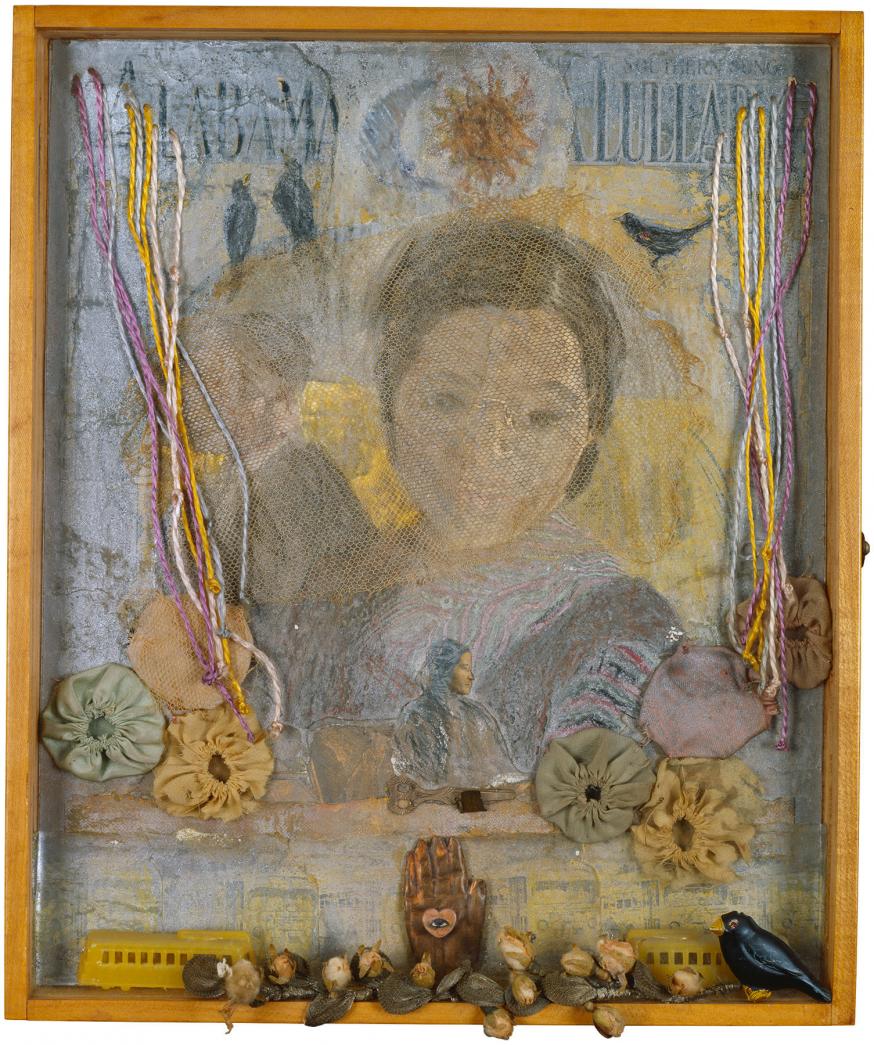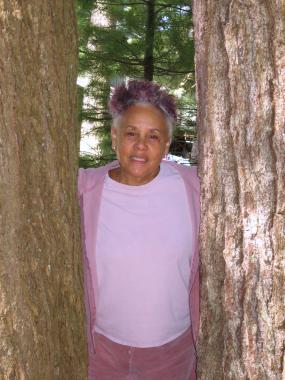Betye Saar
b.1926


Betye Saar at Migis Lodge on Sebago Lake, South Casco, ME, August 2005
All artworks displayed above are currently available. To inquire about additional works available by this artist, please contact the gallery.
Biography
It may not be possible to convey to someone else the mysterious transforming gifts by which dreams, memory, and experience become art. But I like to think I can try.
Betye Saar (b.1926) is known for her mixed media works that address themes of passage, crossroads, death, and rebirth. A native Californian, Saar grew up in Pasadena during the Great Depression. After high school, she took art classes at Pasadena City College, earned a BA from the University of California at Los Angeles in 1949, and pursued graduate studies at California State University at Long Beach, the University of Southern California, and California State University at Northridge. While the hometowns of many artists are often just points of departure, Los Angeles has been a constant presence in Saar’s life and an important source of inspiration. Art historian Jessica Dallow has attributed Saar’s unique blend of interests and approaches to the importance of LA in the 1960s and early 1970s as “a site of geographic convergence of feminism, assemblage art, and black consciousness.”[1]
Saar’s grandmother lived in Watts, and in the 1930s, Saar would visit regularly. The trips not only strengthened her connection to her own family history, they also enabled Saar to witness artist Simon Rodia constructing his famous towers. Saar would watch as Rodia sorted through piles of debris, selecting discarded objects to embed into cement over the towers’ steel frames. She once explained, “I think that was the beginning of me becoming an assemblagist or recycler.”[2] Three decades later, Watts would again affect her artistic development. Observing other LA-based artists like John Outterbridge, Noah Purifoy, and John Scott recycle wreckage from the 1965 riots as material for assemblages, Saar realized the power artists had to transform negative events and objects into creative acts of resistance. The upheavals in Watts became the catalyst for several area artists interested in making art with a political thrust to come together as a group.
In the late 1960s, Saar began to acquire what are euphemistically known as “black collectibles”—everyday objects that featured racist caricatures of African Americans and were found in homes throughout the United States. After the assassination of Dr. Martin Luther King, Jr. in 1968, this ephemera became the cultural debris of racism that she would recycle into art. In 1972, she created her first series of assemblages, The Liberation of Aunt Jemima. In one, a “mammy” figure stands on a field of cotton in front of a series of images of Aunt Jemima. In the center of her body is an image of another “mammy” standing in front of a picket fence and holding a white baby. As Saar explains, “the ‘mammy’ knew and stayed in her place. . . . I attempted to change that ‘place’ . . . . [by turning] a negative, demeaning figure into a positive, empowered woman who stands confrontationally with one hand holding a broom and the other armed for battle. A warrior ready to combat servitude and racism.”[3] She returned to this notion of resisting racism and servitude in such subsequent series as Workers and Warriors and In Service.
Saar voices her political, racial, religious, and gender concerns in her art so that she may “reach across the barriers of art and life, to bridge cultural diversities, and forge new understandings.” Other works have sought to reveal marginalized and hidden histories, ones that are both personal and public. She has examined Asian and African diasporic religions in relation to personal spirituality, the construction of racial hierarchies based on skin tone within black communities, and the ways that objects retain the memories and histories of their owners.
Saar has received numerous awards of distinction, including two National Endowment for the Arts Fellowships (1974, 1984), a J. Paul Getty Fund for the Visual Arts Fellowship (1990), and a Flintridge Foundation Visual Artists Award (1998). In 2013, The Museum of Contemporary Art, Los Angeles, presented her with the Distinguished Women in the Arts Award and in 2015, she was awarded the 55th Annual Edward MacDowell Medal. In 2018, she received the Lifetime Achievement in Contemporary Sculpture Award from the International Sculpture Center in New York and the Skowhegan Medal for Sculpture, awarded by the Skowhegan School of Painting & Sculpture. In 2021, she was awarded the Wolfgang Hahn Prize by the Museum Ludwig in Cologne, Germany, which was accompanied by a solo exhibition of her work.
In 1994, she and artist John Outterbridge represented the United States at the 22nd São Paulo Biennial in Brazil. In 2005, the University of Michigan Museum of Art organized the traveling exhibition Betye Saar: Extending the Frozen Moment, which examined the use of photographic fragments in her work. A role model for generations of women, Saar has raised three daughters, including two accomplished artists (Alison and Lezley). In 2005, the Ackland Art Museum at the University of North Carolina presented work by all three Saar artists in the traveling exhibition Family Legacies: The Art of Betye, Alison and Lezley Saar. The artist’s first European solo exhibition took place in 2015 at the Museum Het Domein Sittard in The Netherlands with the exhibition, Betye Saar: Still Tickin’, an ambitious survey that spanned six decades of the artist’s ouevre and included works on paper, mixed media assemblage, and site-specific installation. Betye Saar: Uneasy Dancer opened at the Fondazione Prada in Milan, Italy the following year. Recent solo exhibitions have included Betye Saar: Keepin’ It Clean at the Craft & Folk Art Museum in Los Angeles, CA and the New-York Historical Society Museum & Library (2018), Betye Saar: Call and Response at the Los Angeles County Museum of Art and The Morgan Library & Museum in New York (2019), Betye Saar: Serious Moonlight at the Institute of Contemporary Art, Miami (2021), and Betye Saar: Heart of a Wanderer at the Isabella Stewart Gardner Museum in Boston, MA (2023). In 2023, the Huntington Library, Art Museum, and Botanical Gardens in San Marino, CA, announced that it had commissioned Saar to create a large-scale, immersive installation for their American Art galleries.
Saar’s work was prominently featured in eight of the museum exhibitions that comprised Pacific Standard Time—a suite of twenty-six exhibitions funded by the Getty Foundation that were shown concurrently in museums throughout California in 2011 and 2012. Her work was included in the Brooklyn Museum’s 2014 traveling exhibition Witness: Art and Civil Rights in the Sixties and in The Color Line: African American Artists and the Civil Rights in the United States at the Musée du Quai Branly, Paris, France (2016) and We Wanted a Revolution: Black Radical Women, 1965–85 at the Brooklyn Museum, New York, NY (2017), which traveled to the California African American Museum, Los Angeles, CA Albright-Knox Art Gallery, Buffalo, NY, and Institute of Contemporary Art, Boston, MA. In 2017, she was featured in the monumental traveling exhibition Soul of a Nation: Art in the Age of Black Power which opened at the Tate Modern in London, England and traveled to Crystal Bridges Museum of American Art, Bentonville, AR; Brooklyn Museum, Brooklyn, NY; The Broad, Los Angeles, CA; de Young Museum, San Francisco, CA; and The Museum of Fine Arts, Houston, Houston, TX. Other group exhibitions include Outliers and American Vanguard Art at the National Gallery of Art, Washington, DC (2018), Black Refractions: Highlights from The Studio Museum in Harlem (2019) and Picturing Motherhood Now: Images for a New Era at The Cleveland Museum of Art, Cleveland, OH (2021).
Michael Rosenfeld Gallery represented Betye Saar for 19 years from 1997 until 2016, mounting six solo exhibitions of her work accompanied by five publications.
The work of Betye Saar is represented in numerous museum collections in the U.S. and Europe including the Detroit Institute of the Arts (MI); High Museum of Art (Atlanta, GA); Hirshhorn Museum and Sculpture Garden, Smithsonian Institution (Washington, DC); Los Angeles County Museum of Art (CA); The Metropolitan Museum of Art (New York, NY); Museum of Fine Arts, Boston (MA); Museum of Modern Art (New York, NY); National Gallery of Art (Washington, DC); The Nelson-Atkins Museum of Art (Kansas City, MO); Philadelphia Museum of Art (PA); San Francisco Museum of Modern Art (CA); Smithsonian American Art Museum (Washington, DC); The Studio Museum in Harlem (New York, NY); Walker Art Center (Minneapolis, MN); and Whitney Museum of American Art (New York, NY); as well as Museum Ludwig in Cologne, Germany and the Tate Modern in London, England.
[1] Jessica Dallow, “Reclaiming Histories: Betye and Alison Saar, Feminism, and the Representation of Black Womanhood,” Feminist Studies vol. 30, no. 1, Spring 2004, 80
[2] Renee Montagne, “Life is a Collage for Artist Betye Saar,” NPR, December 8, 2006, http://www.npr.org/templates/story/story.php?storyId=6688207
[3] Saar, “Unfinished Business: The Return of Aunt Jemima,” Betye Saar: Workers and Warriors: The Return of Aunt Jemima exh. cat. (New York: Michael Rosenfeld Gallery LLC, 1998), 3
Gallery Exhibitions
Press
Publications

